MERCEDES-BENZ SL-Class 2001 R129 Owner's Manual
Manufacturer: MERCEDES-BENZ, Model Year: 2001, Model line: SL-Class, Model: MERCEDES-BENZ SL-Class 2001 R129Pages: 302, PDF Size: 7.21 MB
Page 201 of 302

197 Driving systems
Te ch n ica l
data Instruments
and controlsOperationDrivingInstrument
cluster displayPractical hints Car care Index Normal level
Used for normal operation of the vehicle.
At speeds above approximately 60 mph (95 km/h) the
vehicle chassis is lowered automatically by about one
half inch (15 mm).
Option 1
Level increases one half inch (15 mm)
This setting may be used when road surface conditions
are rough.
When option 1 is selected, the vehicle chassis is raised
by one ha lf inch (15 mm) a t vehicle speed s u p to approx.
35 mph (60 km/h).
At speeds between approximately 35 mph (60 km/h)
and 60 mph (95 km/h) the vehicle chassis is lowered to
its normal level.
At speeds above approximately 60 mph (95 km/h) the
vehicle chassis is lowered an additional one half inch
(15 mm). Notes:
When exceeding approximately 60 mph (95 km/h), the
system switches from option 1 back to Normal Level.
The indicator lamp will go out.
If speed exceeds 35 mph (60 km/h) but does not exceed
60 mph (95 km/h), the vehicle chassis will be
automatically raised again by one half inch (15 mm)
when vehicle speed drops below approx. 35 mph
(60 km/h).
Option 2
Level increases one inch (30 mm)
This setting may be used when road surface conditions
are very rough for increased ground clearance.
Upon selection of option 2 the vehicle chassis is raised
by one inch (30 mm). This option can only be selected at
vehicle standstill, and the raised level is only retained
up to speeds of approximately 15 mph (25 km/h).
At speeds between approximately 15 mph (25 km/h)
and 35 mph (60 km/h) the vehicle chassis is lowered by
one half inch (15 mm).
Page 202 of 302
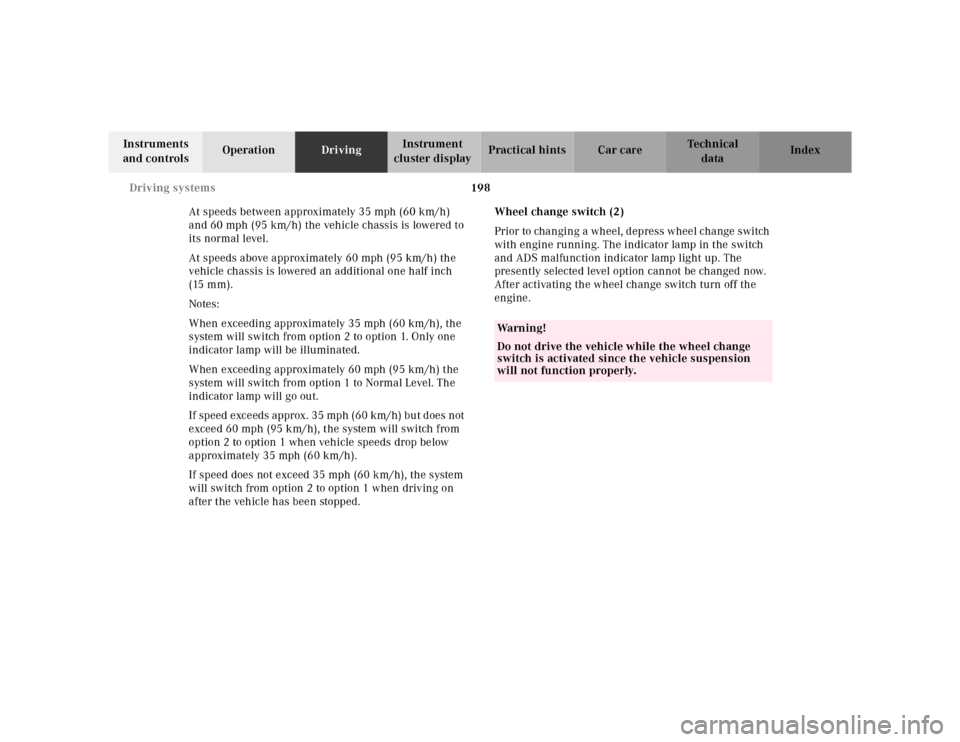
198 Driving systems
Te ch n ica l
data Instruments
and controlsOperationDrivingInstrument
cluster displayPractical hints Car care Index
At speeds between approximately 35 mph (60 km/h)
and 60 mph (95 km/h) the vehicle chassis is lowered to
its normal level.
At speeds above approximately 60 mph (95 km/h) the
vehicle chassis is lowered an additional one half inch
(15 mm).
Notes:
When exceeding approximately 35 mph (60 km/h), the
system will switch from option 2 to option 1. Only one
indicator lamp will be illuminated.
When exceeding approximately 60 mph (95 km/h) the
system will switch from option 1 to Normal Level. The
indicator lamp will go out.
If speed exceeds approx. 35 mph (60 km/h) but does not
exceed 60 mph (95 km/h), the system will switch from
option 2 to option 1 when vehicle speeds drop below
approximately 35 mph (60 km/h).
If speed does not exceed 35 mph (60 km/h), the system
will switch from option 2 to option 1 when driving on
after the vehicle has been stopped.Wheel change switch (2)
Prior to changing a wheel, depress wheel change switch
with engine running. The indicator lamp in the switch
and ADS malfunction indicator lamp light up. The
presently selected level option cannot be changed now.
After activating the wheel change switch turn off the
engine.
Wa r n i n g !
Do not drive the vehicle while the wheel change
switch is activated since the vehicle suspension
will not function properly.
Page 203 of 302

199 Driving systems
Te ch n ica l
data Instruments
and controlsOperationDrivingInstrument
cluster displayPractical hints Car care Index Adaptive Damping System (ADS)
(SL 600 only)
Depending upon road surface conditions, load, driving
style, ADS will automatically adjust the optimal ride
firmness.
The malfunction indicator lamp comes on with the key
in steering lock position 2 and should go out with the
engine running.
If the malfunction indicator lamp stays on after the
engine is running or comes on while driving, then the
system has detected a malfunction.
Have the ADS checked at your authorized
Mercedes-Benz Center as soon as possible.
Note:
If the power supply was interrupted (battery
disconnected or empty), the malfunction indicator lamp
will light up when the engine is running.
Turn the steering wheel from full left to full right lock
position. The light should go out. Adaptive damping system adjustment
The switch is located in the center console.
1Firm dampening program. This setting should be
used for sporty driving. During the setting for sporty
driving the indicator lamp in the switch lights up.
2Soft dampening program. This setting should be
used for regular driving.
Page 204 of 302
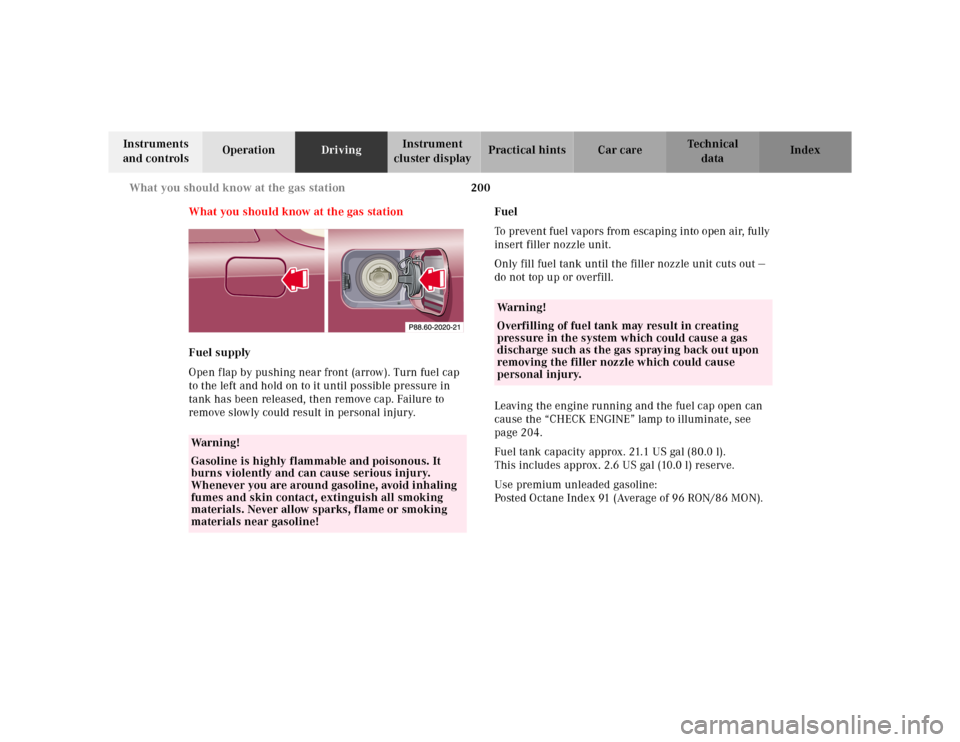
200 What you should know at the gas station
Te ch n ica l
data Instruments
and controlsOperationDrivingInstrument
cluster displayPractical hints Car care Index
What you should know at the gas station
Fuel supply
Open flap by pushing near front (arrow). Turn fuel cap
to the left and hold on to it until possible pressure in
tank has been released, then remove cap. Failure to
remove slowly could result in personal injury.Fuel
To prevent fuel vapors from escaping into open air, fully
insert filler nozzle unit.
Only fill fuel tank until the filler nozzle unit cuts out —
do not top up or overfill.
Leaving the engine running and the fuel cap open can
cause the “CHECK ENGINE” lamp to illuminate, see
page 204.
Fuel tank capacity approx. 21.1 US gal (80.0 l).
This includes approx. 2.6 US gal (10.0 l) reserve.
Use premium unleaded gasoline:
Posted Octane Index 91 (Average of 96 RON/86 MON).
Wa r n i n g !
Gasoline is highly flammable and poisonous. It
burns violently and can cause serious injury.
Whenever you are around gasoline, avoid inhaling
fumes and skin contact, extinguish all smoking
materials. Never allow sparks, flame or smoking
materials near gasoline!
Wa r n i n g !
Overfilling of fuel tank may result in creating
pressure in the system which could cause a gas
discharge such as the gas spraying back out upon
removing the filler nozzle which could cause
personal injury.
Page 205 of 302
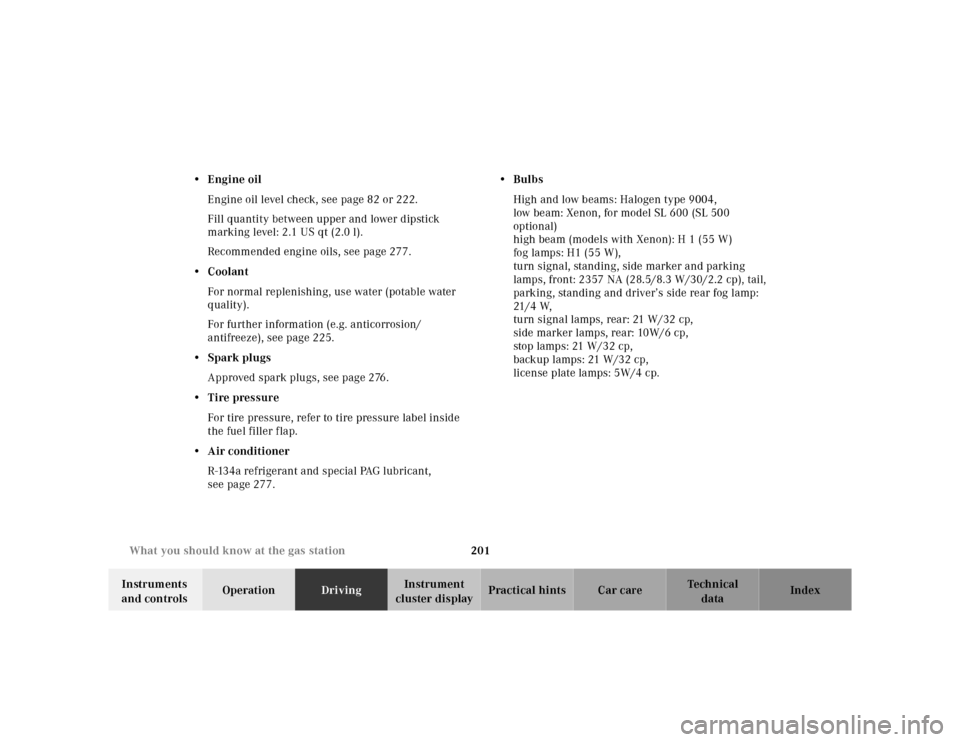
201 What you should know at the gas station
Te ch n ica l
data Instruments
and controlsOperationDrivingInstrument
cluster displayPractical hints Car care Index •Engine oil
Engine oil level check, see page 82 or 222.
Fill quantity between upper and lower dipstick
marking level: 2.1 US qt (2.0 l).
Recommended engine oils, see page 277.
•Coolant
For normal replenishing, use water (potable water
quality).
For further information (e.g. anticorrosion/
antifreeze), see page 225.
•Spark plugs
Approved spark plugs, see page 276.
•Tire pressure
For tire pressure, refer to tire pressure label inside
the fuel filler flap.
•Air conditioner
R-134a refrigerant and special PAG lubricant,
see page 277.•Bulbs
High and low beams: Halogen type 9004,
low beam: Xenon, for model SL 600 (SL 500
optional)
high beam (models with Xenon): H 1 (55 W)
fog lamps: H1 (55 W),
turn signal, standing, side marker and parking
lamps, front: 2357 NA (28.5/8.3 W/30/2.2 cp), tail,
parking, standing and driver’s side rear fog lamp:
21 / 4 W,
turn signal lamps, rear: 21 W/32 cp,
side marker lamps, rear: 10W/6 cp,
stop lamps: 21 W/32 cp,
backup lamps: 21 W/32 cp,
license plate lamps: 5W/4 cp.
Page 206 of 302
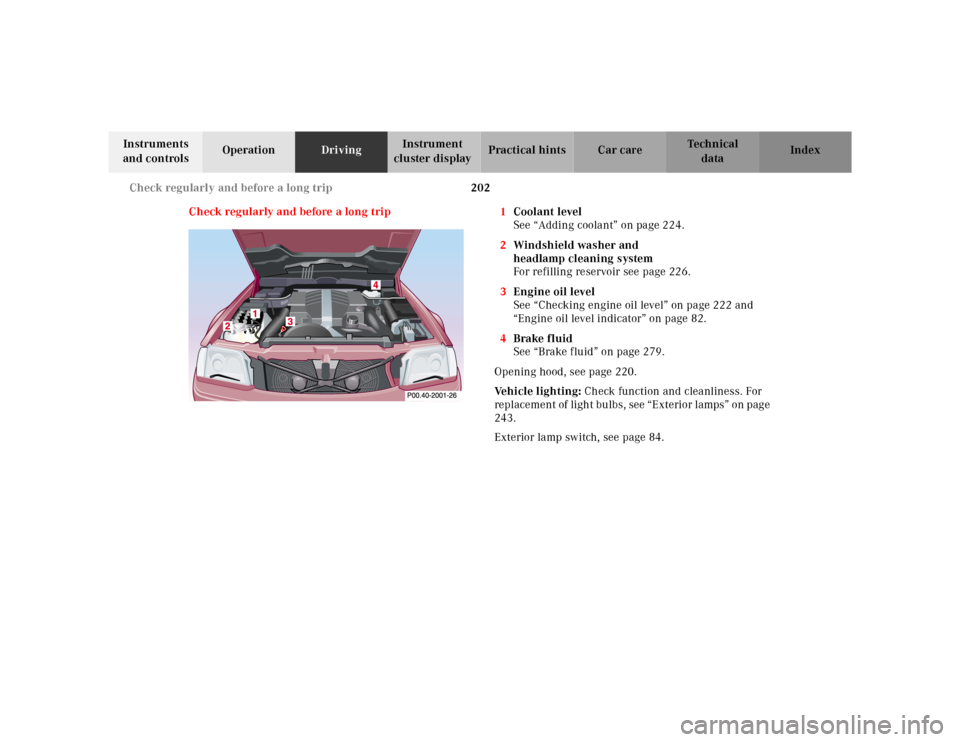
202 Check regularly and before a long trip
Te ch n ica l
data Instruments
and controlsOperationDrivingInstrument
cluster displayPractical hints Car care Index
Check regularly and before a long trip 1Coolant level
See “Adding coolant” on page 224.
2Windshield washer and
headlamp cleaning system
For refilling reservoir see page 226.
3Engine oil level
See “Checking engine oil level” on page 222 and
“Engine oil level indicator” on page 82.
4Brake fluid
See “Brake fluid” on page 279.
Opening hood, see page 220.
Ve h i c l e l i g h t i n g : Check function and cleanliness. For
replacement of light bulbs, see “Exterior lamps” on page
243.
Exterior lamp switch, see page 84.
Page 207 of 302
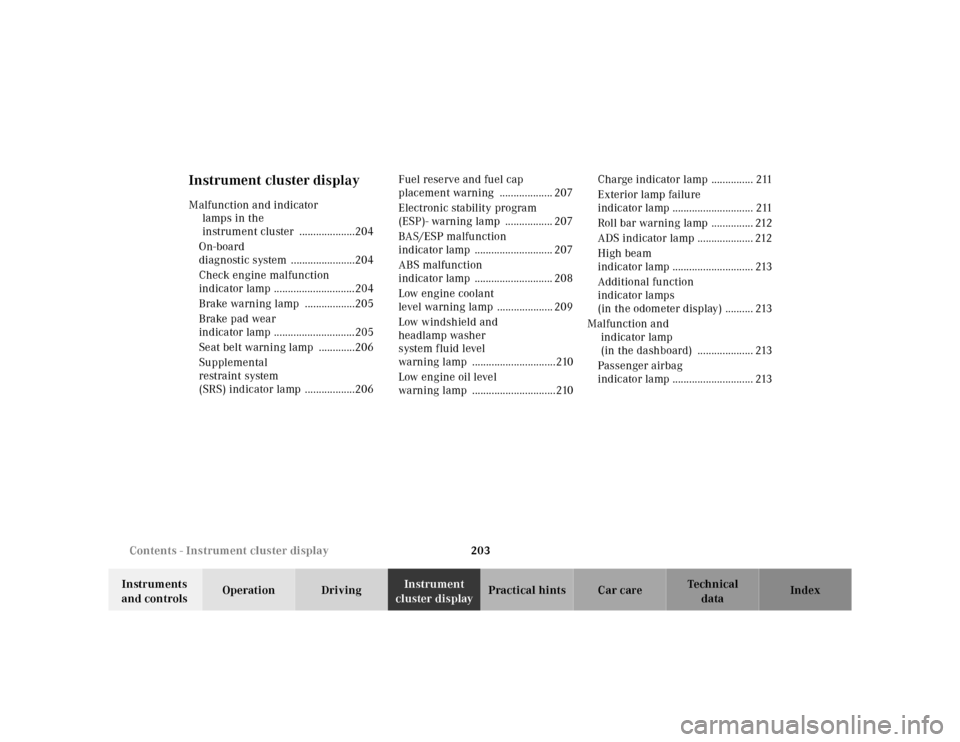
203 Contents - Instrument cluster display
Te ch n ica l
data Instruments
and controlsOperation DrivingInstrument
cluster displayPractical hints Car care Index
Instrument cluster display Malfunction and indicator
lamps in the
instrument cluster ....................204
On-board
diagnostic system .......................204
Check engine malfunction
indicator lamp .............................204
Brake warning lamp ..................205
Brake pad wear
indicator lamp .............................205
Seat belt warning lamp .............206
Supplemental
restra int system
(SRS) indicator lamp ..................206Fuel reserve and fuel cap
placement warning ................... 207
Electronic stability program
(ESP)- warning lamp ................. 207
BAS/ESP malfunction
indicator lamp ............................ 207
ABS malfunction
indicator lamp ............................ 208
Low engine coolant
level warning lamp .................... 209
Low windshield and
headlamp washer
system fluid level
warning lamp ..............................210
Low engine oil level
warning lamp ..............................210Charge indicator lamp ............... 211
Exterior lamp failure
indicator lamp ............................. 211
Roll bar warning lamp ............... 212
ADS indicator lamp .................... 212
High beam
indicator lamp ............................. 213
Additional function
indicator lamps
(in the odometer display) .......... 213
Malfunction and
indicator lamp
(in the dashboard) .................... 213
Passenger airbag
indicator lamp ............................. 213
Page 208 of 302
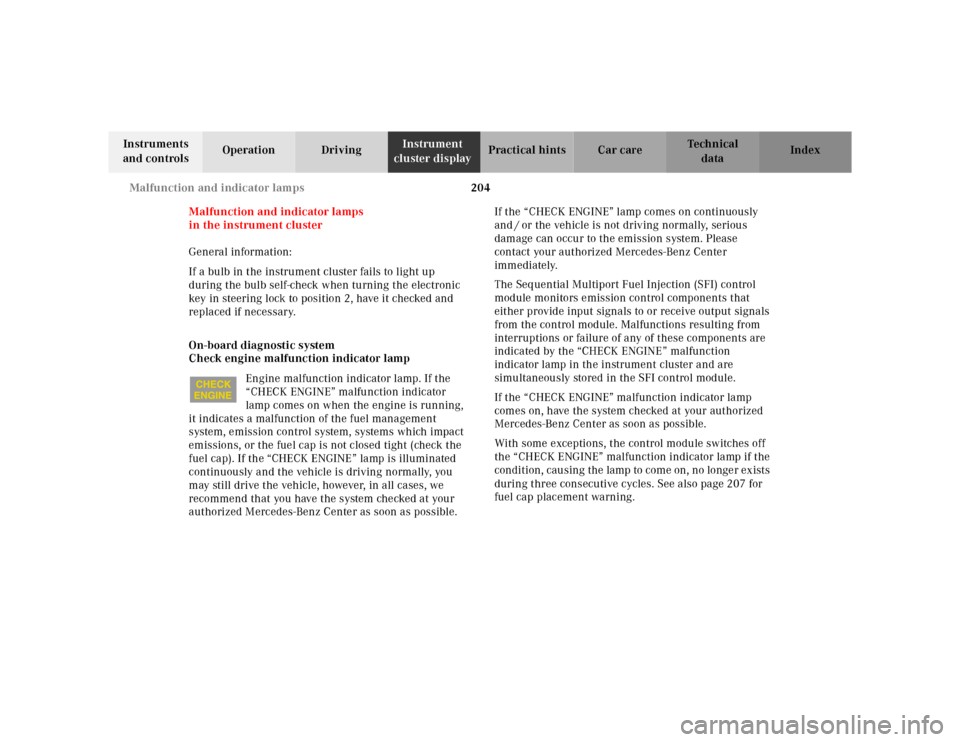
204 Malfunction and indicator lamps
Te ch n ica l
data Instruments
and controlsOperation DrivingInstrument
cluster displayPractical hints Car care Index
Malfunction and indicator lamps
in the instrument cluster
General information:
If a bulb in the instrument cluster fails to light up
during the bulb self-check when turning the electronic
key in steering lock to position 2, have it checked and
replaced if necessary.
On-board diagnostic system
Check engine malfunction indicator lamp
Engine malfunction indicator lamp. If the
“CHECK ENGINE” malfunction indicator
lamp comes on when the engine is running,
it indicates a malfunction of the fuel management
system, emission control system, systems which impact
emissions, or the fuel cap is not closed tight (check the
fuel cap). If the “CHECK ENGINE” lamp is illuminated
continuously and the vehicle is driving normally, you
may still drive the vehicle, however, in all cases, we
recommend that you have the system checked at your
authorized Mercedes-Benz Center as soon as possible. If the “CHECK ENGINE” lamp comes on continuously
and / or the vehicle is not driving normally, serious
damage can occur to the emission system. Please
contact your authorized Mercedes-Benz Center
immediately.
The Sequential Multiport Fuel Injection (SFI) control
module monitors emission control components that
either provide input signals to or receive output signals
from the control module. Malfunctions resulting from
interruptions or failure of any of these components are
indicated by the “CHECK ENGINE” malfunction
indicator lamp in the instrument cluster and are
simultaneously stored in the SFI control module.
If the “CHECK ENGINE” malfunction indicator lamp
comes on, have the system checked at your authorized
Mercedes-Benz Center as soon as possible.
With some exceptions, the control module switches off
the “CHECK ENGINE” malfunction indicator lamp if the
condition, causing the lamp to come on, no longer exists
during three consecutive cycles. See also page 207 for
fuel cap placement warning.
Page 209 of 302
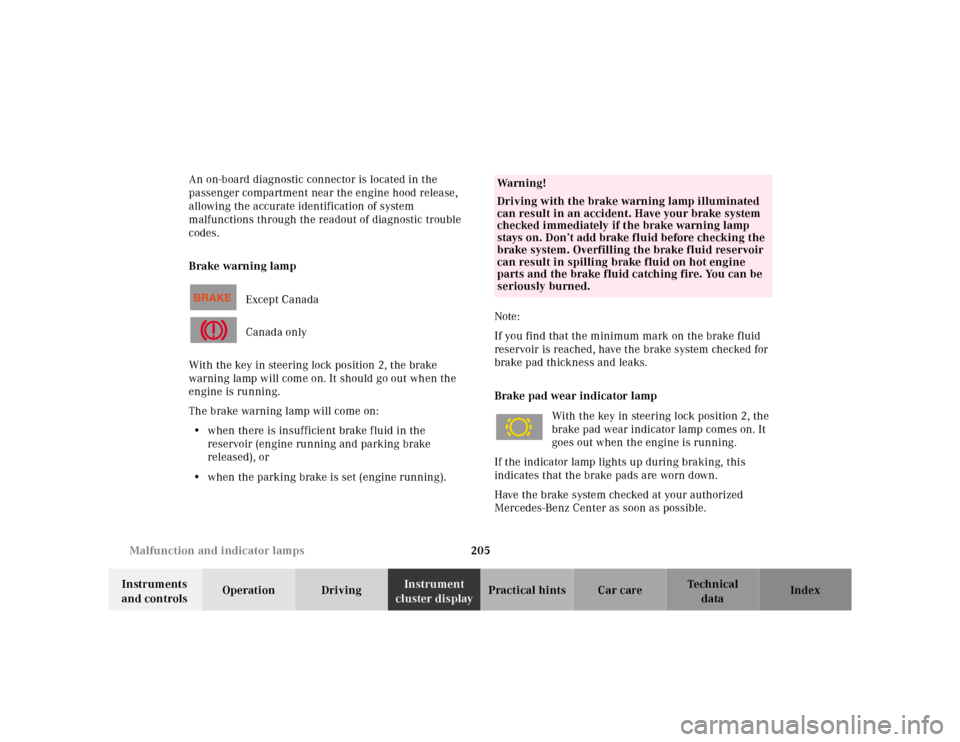
205 Malfunction and indicator lamps
Te ch n ica l
data Instruments
and controlsOperation DrivingInstrument
cluster displayPractical hints Car care Index An on-board diagnostic connector is located in the
passenger compartment near the engine hood release,
allowing the accurate identification of system
malfunctions through the readout of diagnostic trouble
codes.
Brake warning lamp
Except Canada
Canada only
With the key in steering lock position 2, the brake
warning lamp will come on. It should go out when the
engine is running.
The brake warning lamp will come on:
• when there is insufficient brake fluid in the
reservoir (engine running and parking brake
released), or
• when the parking brake is set (engine running).Note:
If you find that the minimum mark on the brake fluid
reservoir is reached, have the brake system checked for
brake pad thickness and leaks.
Brake pad wear indicator lamp
With the key in steering lock position 2, the
brake pad wear indicator lamp comes on. It
goes out when the engine is running.
If the indicator lamp lights up during braking, this
indicates that the brake pads are worn down.
Have the brake system checked at your authorized
Mercedes-Benz Center as soon as possible.
Wa r n i n g !
Driving with the brake warning lamp illuminated
can result in an accident. Have your brake system
checked immediately if the brake warning lamp
stays on. Don’t add brake fluid before checking the
brake system. Overfilling the brake fluid reservoir
can result in spilling brake fluid on hot engine
parts and the brake fluid catching fire. You can be
seriously burned.
Page 210 of 302
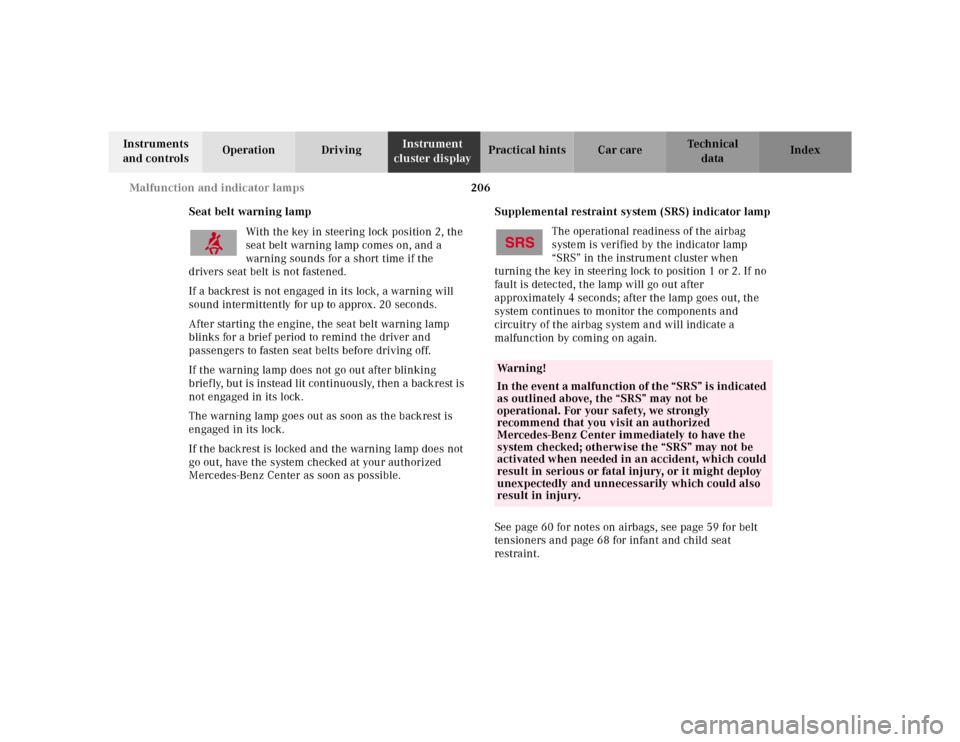
206 Malfunction and indicator lamps
Te ch n ica l
data Instruments
and controlsOperation DrivingInstrument
cluster displayPractical hints Car care Index
Seat belt warning lamp
With the key in steering lock position 2, the
seat belt warning lamp comes on, and a
warning sounds for a short time if the
drivers seat belt is not fastened.
If a backrest is not engaged in its lock, a warning will
sound intermittently for up to approx. 20 seconds.
After starting the engine, the seat belt warning lamp
blinks for a brief period to remind the driver and
passengers to fasten seat belts before driving off.
If the warning lamp does not go out after blinking
briefly, but is instead lit continuously, then a backrest is
not engaged in its lock.
The warning lamp goes out as soon as the backrest is
engaged in its lock.
If the backrest is locked and the warning lamp does not
go out, have the system checked at your authorized
Mercedes-Benz Center as soon as possible.Supplemental restraint system (SRS) indicator lamp
The operational readiness of the airbag
system is verified by the indicator lamp
“SRS” in the instrument cluster when
turning the key in steering lock to position 1 or 2. If no
fault is detected, the lamp will go out after
approximately 4 seconds; after the lamp goes out, the
system continues to monitor the components and
circuitry of the airbag system and will indicate a
malfunction by coming on again.
See page 60 for notes on airbags, see page 59 for belt
tensioners and page 68 for infant and child seat
restraint.
Wa r n i n g !
In the event a malfunction of the “SRS” is indicated
as outlined above, the “SRS” may not be
operational. For your safety, we strongly
recommend that you visit an authorized
Mercedes-Benz Center immediately to have the
system checked; otherwise the “SRS” may not be
activated when needed in an accident, which could
result in serious or fatal injury, or it might deploy
unexpectedly and unnecessarily which could also
result in injury.